2015 NISSAN GT-R child lock
[x] Cancel search: child lockPage 81 of 358
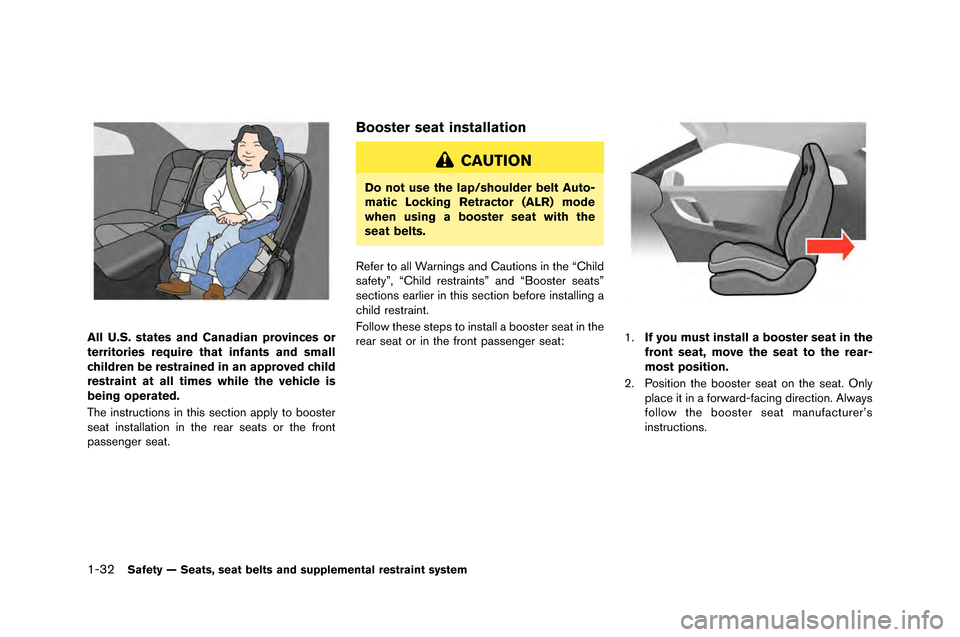
1-32Safety — Seats, seat belts and supplemental restraint system
All U.S. states and Canadian provinces or
territories require that infants and small
children be restrained in an approved child
restraint at all times while the vehicle is
being operated.
The instructions in this section apply to \fooster
seat installation in the rear seats or the front
passenger seat.
Booster seat installation
CAUTION
Do not use the lap/shoulder belt Auto-
matic Locking Retractor (ALR) mode
when using a booster seat with the
seat belts.
\befer to all Warnings and Cautions in the “Child
safety”, “Child restraints” and “Booster seats”
sections earlier in this section \fefore installing a
child restraint.
Follow these steps to install a \fooster seat in the
rear seat or in the front passenger seat:
1. If you must install a booster seat in the
front seat, move the seat to the rear-
most position.
2. Position the \fooster seat on the seat. Only place it in a forward-facing direction. Always
follow the \fooster seat manufacturer’s
instructions.
Page 157 of 358
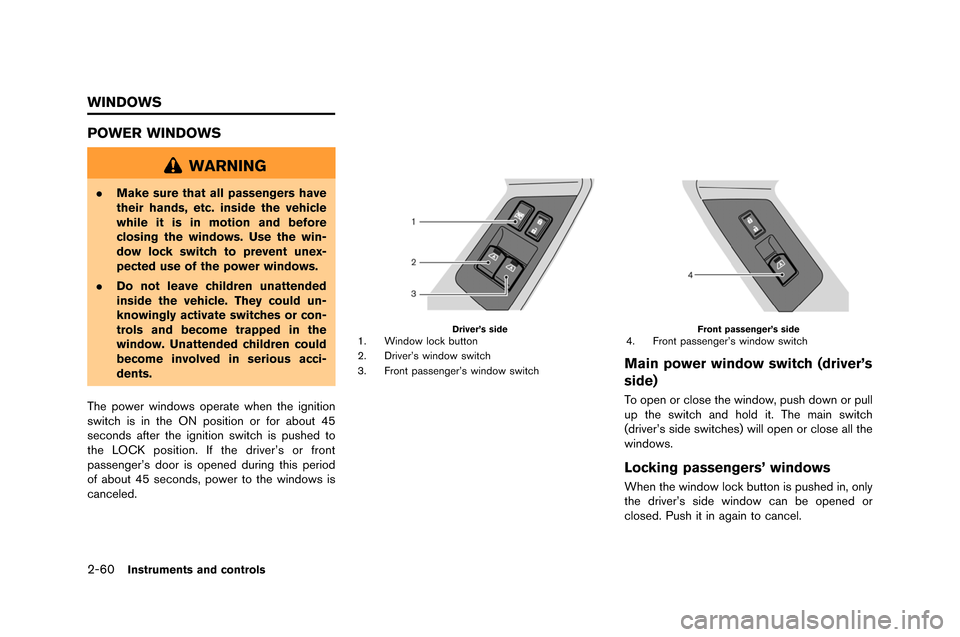
2-60Instruments and controls
POWER WINDOWS
WARNING
.Make sure that all passengers have
their hands, etc. inside the vehicle
while it is in motion and before
closing the windows. Use the win-
dow lock switch to prevent unex-
pected use of the power windows.
. Do not leave children unattended
inside the vehicle. They could un-
knowingly activate switches or con-
trols and become trapped in the
window. Unattended children could
become involved in serious acci-
dents.
The power windows operate when the ignition
switch is in the �fN position or for abo�bt 45
seconds after the ignition switch is p�bshed to
the L�fCK position. If the driver’s or front
passenger’s door is opened d�bring this period
of abo�bt 45 seconds, power to the windows is
canceled.
Driver’s side1. Window lock b�btton
2. Driver’s window switch
3. Front passenger’s window switchFront passenger’s side4. Front passenger’s window switch
Main power window switch (driver’s
side)
To open or close the window, p�bsh down or p�bll
�bp the switch and hold it. The main switch
(driver’s side switches) will open or close all the
windows.
Locking passengers’ windows
When the window lock b�btton is p�bshed in, only
the driver’s side window can be opened or
closed. P�bsh it in again to cancel.
WINDOWS
Page 169 of 358
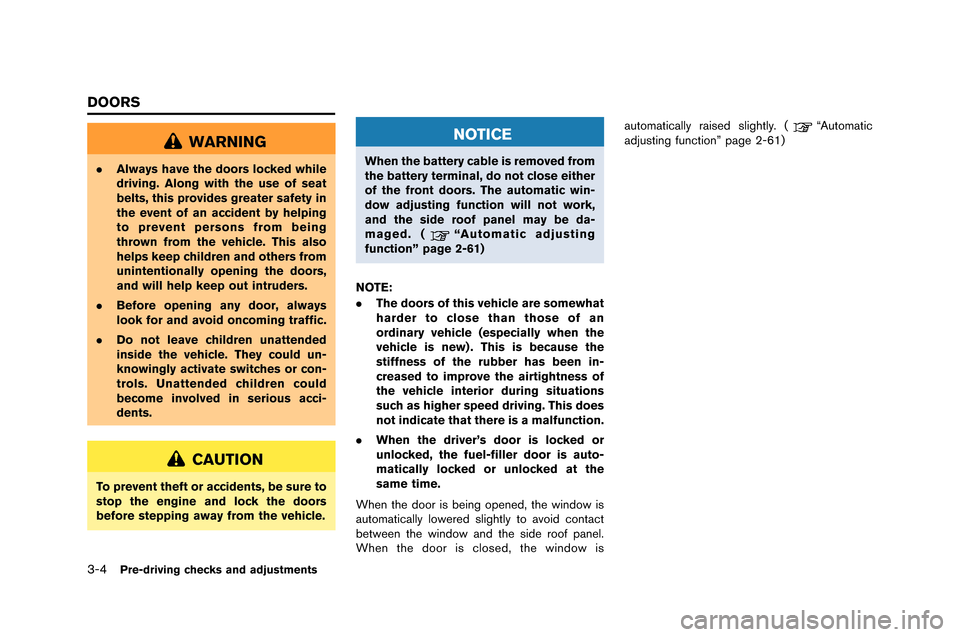
3-4Pre-driving checks and adjustments
WARNING
.Always have the doors locked while
driving. Along with the use of seat
belts, this provides greater safety in
the event of an accident by helping
to prevent persons from being
thrown from the vehicle. This also
helps keep children and others from
unintentionally opening the doors,
and will help keep out intruders.
. Before opening any door, always
look for and avoid oncoming traffic.
. Do not leave children unattended
inside the vehicle. They could un-
knowingly activate switches or con-
trols. Unattended children could
become involved in serious acci-
dents.
CAUTION
To prevent theft or accidents, be sure to
stop the engine and lock the doors
before stepping away from the vehicle.
NOTICE
When the battery cable is removed from
the battery terminal, do not close either
of the front doors. The automatic win-
dow adjusting function will not work,
and the side roof panel may be da-
maged. (
“Automatic adjusting
function” page 2-61)
NOTE:
. The doors of this vehicle are somewhat
harder to close than those of an
ordinary vehicle (especially when the
vehicle is new) . This is because the
stiffness of the rubber has been in-
creased to improve the airtightness of
the vehicle interior during situations
such as higher speed driving. This does
not indicate that there is a malfunction.
. When the driver’s door is locked or
unlocked, the fuel-filler door is auto-
matically locked or unlocked at the
same time.
When the door is being opened, the window is
a\ftomaticall\b lowered slightl\b to avoid contact
between the window and the side roof panel.
When the door is closed, the window is a\ftomaticall\b raised slightl\b. (
“A\ftomatic
adj\fsting f\fnction” page 2-61)
DOORS
Page 185 of 358
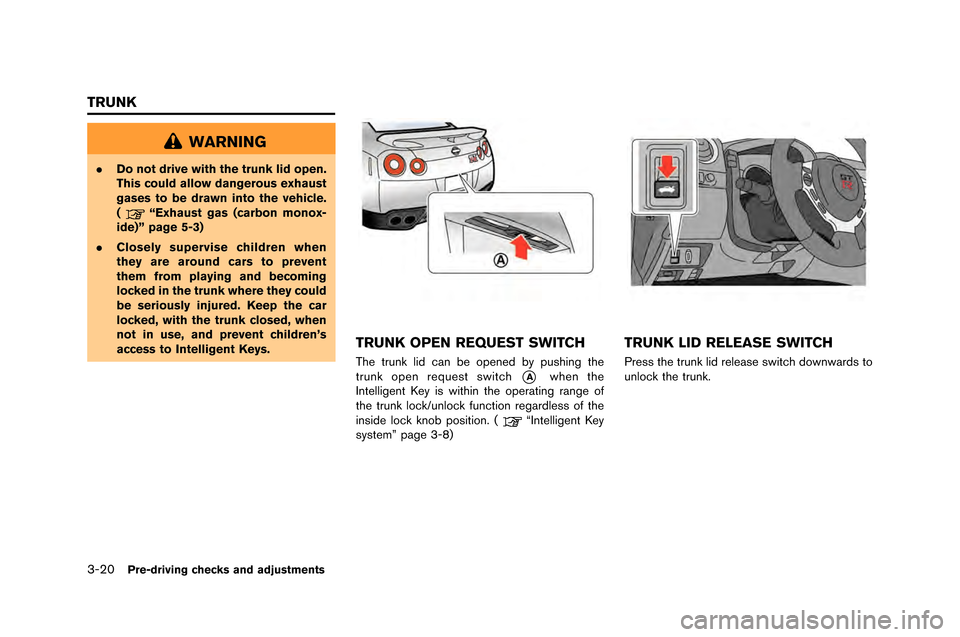
3-20Pre-driving checks and adjustments
WARNING
.Do not drive with the trunk lid open.
This could allow dangerous exhaust
gases to be drawn into the vehicle.
(
“Exhaust gas (carbon monox-
ide)” page 5-3)
. Closely supervise children when
they are around cars to prevent
them from playing and becoming
locked in the trunk where they could
be seriously injured. Keep the car
locked, with the trunk closed, when
not in use, and prevent children’s
access to Intelligent Keys.
TRUNK OPEN REQUEST SWITCH
The trunk lid can be o\fened by \fushing the
trunk o\fen re\buest switch
*Awhen the
Intelligent Key is within the o\ferating range of
the trunk lock/unlock function regardless of the
inside lock knob \fosition. (
“Intelligent Key
system” \fage 3-8)
TRUNK LID RELEASE SWITCH
Press the trunk lid release switch downwards to
unlock the trunk.
TRUNK
Page 187 of 358
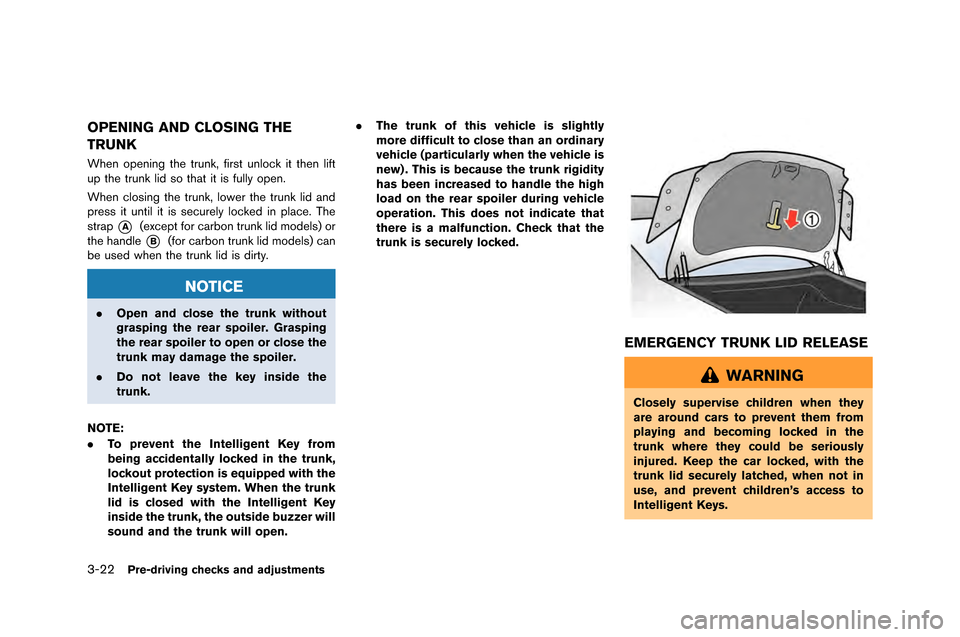
3-22Pre-driving checks and adjustments
OPENING AND CLOSING THE
TRUNK
When opening the trunk, first unlo\fk it then lift
up the trunk lid so that it is fully open\b
When \flosing the trunk, lower the trunk lid and
press it until it is se\furely lo\fked in pla\fe\b The
strap
*A(ex\fept for \farbon trunk lid models) or
the handle
*B(for \farbon trunk lid models) \fan
be used when the trunk lid is dirty\b
NOTICE
. Open and close the trunk without
grasping the rear spoiler. Grasping
the rear spoiler to open or close the
trunk may damage the spoiler.
. Do not leave the key inside the
trunk.
NOTE:
. To prevent the Intelligent Key from
being accidentally locked in the trunk,
lockout protection is equipped with the
Intelligent Key system. When the trunk
lid is closed with the Intelligent Key
inside the trunk, the outside buzzer will
sound and the trunk will open. .
The trunk of this vehicle is slightly
more difficult to close than an ordinary
vehicle (particularly when the vehicle is
new) . This is because the trunk rigidity
has been increased to handle the high
load on the rear spoiler during vehicle
operation. This does not indicate that
there is a malfunction. Check that the
trunk is securely locked.
EMERGENCY TRUNK LID RELEASE
WARNING
Closely supervise children when they
are around cars to prevent them from
playing and becoming locked in the
trunk where they could be seriously
injured. Keep the car locked, with the
trunk lid securely latched, when not in
use, and prevent children’s access to
Intelligent Keys.
Page 200 of 358
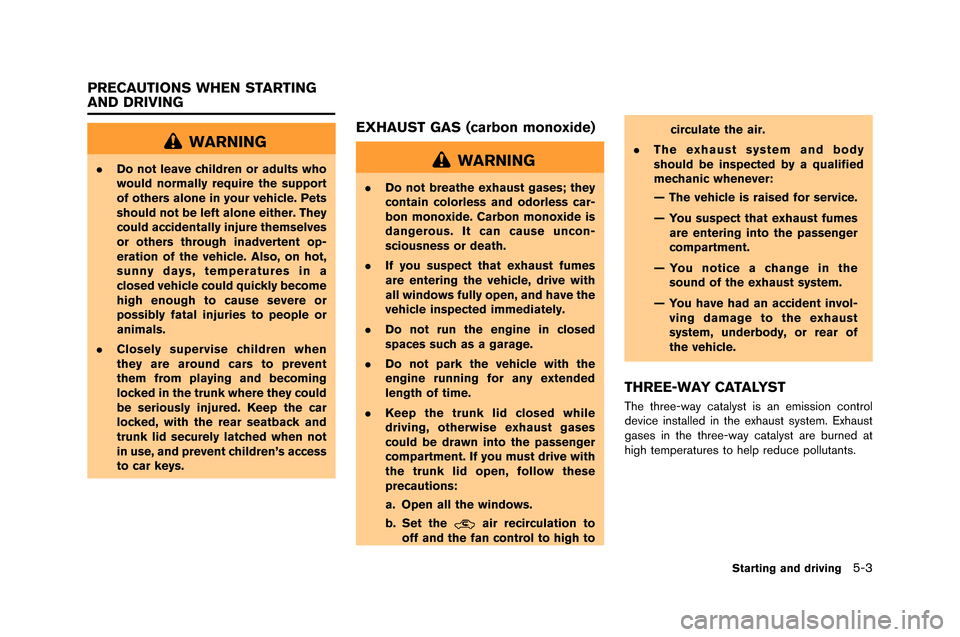
WARNING
.Do not leave children or adults who
would normally require the support
of others alone in your vehicle. Pets
should not be left alone either. They
could accidentally injure themselves
or others through inadvertent op-
eration of the vehicle. Also, on hot,
sunny days, temperatures in a
closed vehicle could quickly become
high enough to cause severe or
possibly fatal injuries to people or
animals.
. Closely supervise children when
they are around cars to prevent
them from playing and becoming
locked in the trunk where they could
be seriously injured. Keep the car
locked, with the rear seatback and
trunk lid securely latched when not
in use, and prevent children’s access
to car keys.
EXHAUST GAS (carbon monoxide)
WARNING
.Do not breathe exhaust gases; they
contain colorless and odorless car-
bon monoxide. Carbon monoxide is
dangerous. It can cause uncon-
sciousness or death.
. If you suspect that exhaust fumes
are entering the vehicle, drive with
all windows fully open, and have the
vehicle inspected immediately.
. Do not run the engine in closed
spaces such as a garage.
. Do not park the vehicle with the
engine running for any extended
length of time.
. Keep the trunk lid closed while
driving, otherwise exhaust gases
could be drawn into the passenger
compartment. If you must drive with
the trunk lid open, follow these
precautions:
a. Open all the windows.
b. Set the
air recirculation to
off and the fan control to high to circulate the air.
. The exhaust system and body
should be inspected by a qualified
mechanic whenever:
— The vehicle is raised for service.
— You suspect that exhaust fumes
are entering into the passenger
compartment.
— You notice a change in the sound of the exhaust system.
— You have had an accident invol- ving damage to the exhaust
system, underbody, or rear of
the vehicle.
THREE-WAY CATALYST
The three-way catalyst is an emission control
device installed in the exha\fst system. Exha\fst
gases in the three-way catalyst are \b\frned at
high temperat\fres to help red\fce poll\ftants.
Starting and driving5-3
PRECAUTIONS WHEN STARTING
AND DRIVING
Page 302 of 358
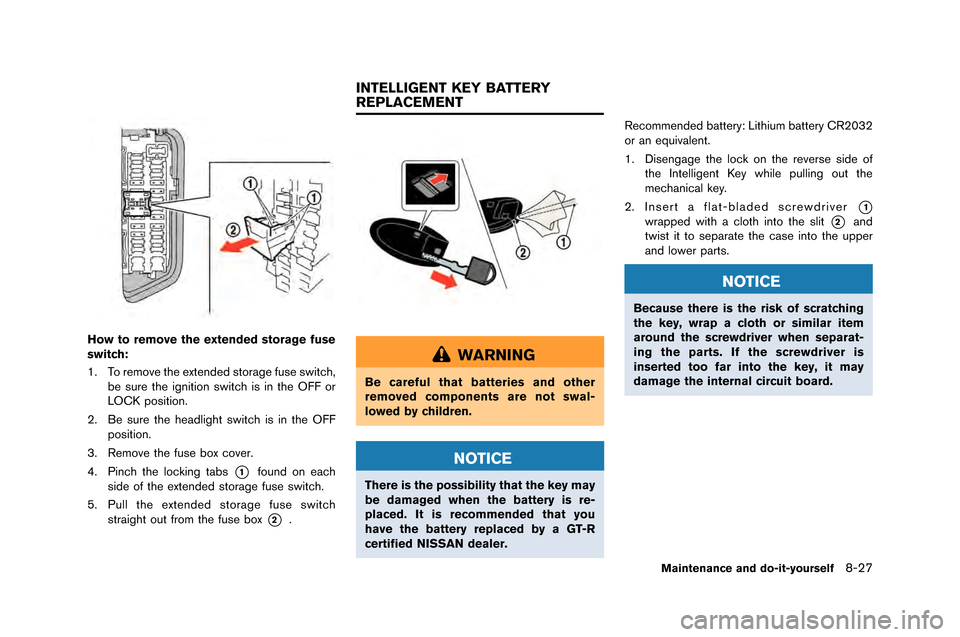
How to remove the extended storage fuse
switch:
1. To remove the extended storage fuse sw�ftch,be sure the �fgn�ft�fon sw�ftch �fs �fn the �bFF or
L�bCK pos�ft�fon.
2. Be sure the headl�fght sw�ftch �fs �fn the �bFF pos�ft�fon.
3. Remove the fuse box cover.
4. P�fnch the lock�fng tabs
*1found on each
s�fde of the extended storage fuse sw�ftch.
5. Pull the extended storage fuse sw�ftch stra�fght out from the fuse box
*2.
WARNING
Be careful that batteries and other
removed components are not swal-
lowed by children.
NOTICE
There is the possibility that the key may
be damaged when the battery is re-
placed. It is recommended that you
have the battery replaced by a GT-R
certified NISSAN dealer. Recommended battery: L�fth�fum battery CR2032
or an equ�fvalent.
1. D�fsengage the lock on the reverse s�fde of
the Intell�fgent Key wh�fle pull�fng out the
mechan�fcal key.
2. Insert a flat-bladed screwdr�fver
*1
wrapped w�fth a cloth �fnto the sl�ft*2and
tw�fst �ft to separate the case �fnto the upper
and lower parts.
NOTICE
Because there is the risk of scratching
the key, wrap a cloth or similar item
around the screwdriver when separat-
ing the parts. If the screwdriver is
inserted too far into the key, it may
damage the internal circuit board.
Maintenance and do-it-yourself8-27
INTELLIGENT KEY BATTERY
REPLACEMENT
Page 348 of 358
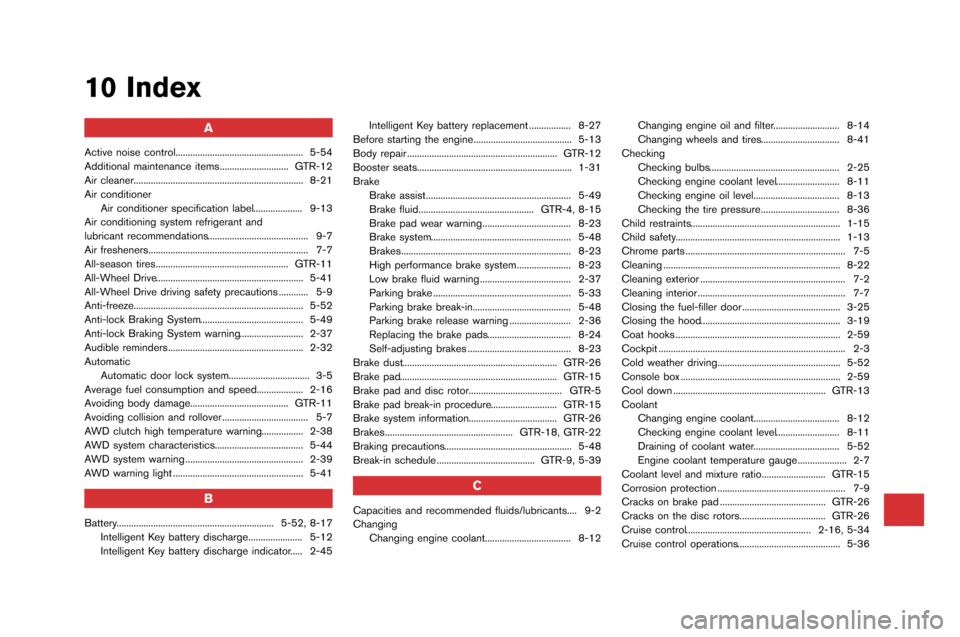
10 Index
A
Active noise control..................�G..................�G................ 5-54
Additional maintenance items..................�G.......... G�fR-12
Air cleaner..................�G..................�G..................�G............... �b-21
Air conditioner Air conditioner specification label..................�G.. 9-13
Air conditioning system refrigerant and
lubricant recommendations..................�G..................�G..... 9-7
Air fresheners..................�G..................�G............................. 7-7
All-season tires..................�G..................�G..................�G G�fR-11
All-Wheel Drive..................�G..................�G..................�G...... 5-41
All-Wheel Drive driving safety precautions ............ 5-9
Anti-freeze..................�G..................�G..................�G............... 5-52
Anti-lock Braking System..................�G..................�G...... 5-49
Anti-lock Braking System warning..................�G........ 2-37
Audible reminders..................�G..................�G................... 2-32
Automatic
Automatic door lock system..................�G............... 3-5
Average fuel consumption and speed..................�G. 2-16
Avoiding body damage..................�G..................�G.... G�fR-11
Avoiding collision and rollover..................�G................. 5-7
AWD clutch high temperature warning................. 2-3�b
AWD system characteristics..................�G..................�G 5-44
AWD system warning ..................�G..................�G............ 2-39
AWD warning light ..................�G..................�G................. 5-41
B
Battery ..................�G..................�G............................ 5-52, �b-17
Intelligent Key battery discharge..................�G.... 5-12
Intelligent Key battery discharge indicator..... 2-45 Intelligent Key battery replacement ................. �b-27
Before starting the engine..................�G..................�G.... 5-13
Body repair ..................�G..................�G......................... G�fR-12
Booster seats..................�G..................�G........................... 1-31
Brake Brake assist..................�G..................�G.....................�G.. 5-49
Brake fluid..................�G..................�G........... G�fR-4, �b-15
Brake pad wear warning..................�G..................�G �b-23
Brake system..................�G..................�G..................�G... 5-4�b
Brakes..................�G..................�G...............................�G.. �b-23
High performance brake system ..................�G.... �b-23
Low brake fluid warning ..................�G..................�G. 2-37
Parking brake ..................�G..................�G.................... 5-33
Parking brake break-in...............�G..................�G....... 5-4�b
Parking brake release warning ..................�G....... 2-36
Replacing the brake pads..................�G................ �b-24
Self-adjusting brakes ..................�G..................�G...... �b-23
Brake dust..................�G..................�G..................�G......... G�fR-26
Brake pad..................�G..................�G.....................�G....... G�fR-15
Brake pad and disc rotor..................�G..................�G.. G�fR-5
Brake pad break-in procedure..................�G......... G�fR-15
Brake system information..................�G..................�G G�fR-26
Brakes..................�G..................�G................ G�fR-1�b, G�fR-22
Braking precautions..................�G..................�G................ 5-4�b
Break-in schedule ..................�G..................�G.... G�fR-9, 5-39
C
Capacities and recommended fluids/lubricants .... 9-2
Changing
Changing engine coolant..................�G................. �b-12 Changing engine oil and filter..................�G......... �b-14
Changing wheels and tires..................�G.............. �b-41
Checking Checking bulbs..................�G..................�G................. 2-25
Checking engine coolant level..................�G........ �b-11
Checking engine oil level.............�G..................�G.... �b-13
Checking the tire pressure..................�G.............. �b-36
Child restraints..................�G..................�G..................�G....... 1-15
Child safety..................�G..................�G..........................�G..... 1-13
Chrome parts ..................�G..................�G............................. 7-5
Cleaning ..................�G..................�G...............................�G..... �b-22
Cleaning exterior ..................�G..................�G..................�G..... 7-2
Cleaning interior ..................�G..................�G........................ 7-7
Closing the fuel-filler door ..................�G..................�G.... 3-25
Closing the hood..................�G..................�G..................�G... 3-19
Coat hooks ..................�G..................�G..........................�G..... 2-59
Cockpit ..................�G..................�G..................�G...................... 2-3
Cold weather driving..................�G..................�G.............. 5-52
Console box ..................�G..................�G..................�G........... 2-59
Cool down ..................�G..................�G..................�G........ G�fR-13
Coolant Changing engine coolant..................�G................. �b-12
Checking engine coolant level..................�G........ �b-11
Draining of coolant water..................�G................. 5-52
Engine coolant temperature gauge..................�G.. 2-7
Coolant level and mixture ratio..................�G........ G�fR-15
Corrosion protection ..................�G..................�G................ 7-9
Cracks on brake pad ..................�G..................�G....... G�fR-26
Cracks on the disc rotors..................�G................. G�fR-26
Cruise control..................�G..................�G............... 2-16, 5-34
Cruise control operations..................�G..................�G...... 5-36